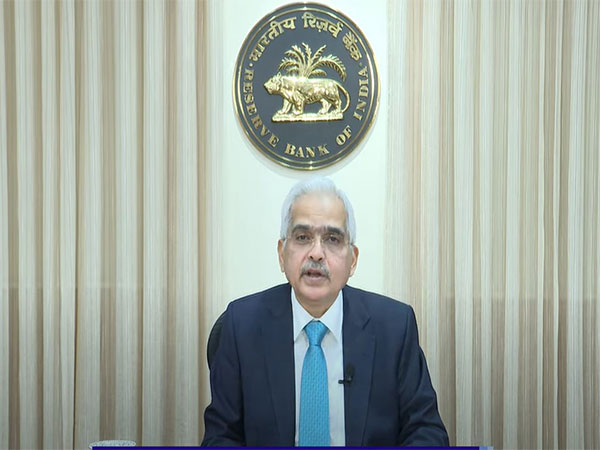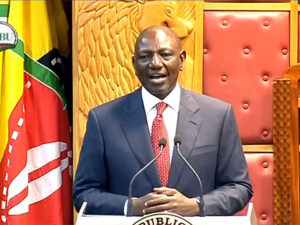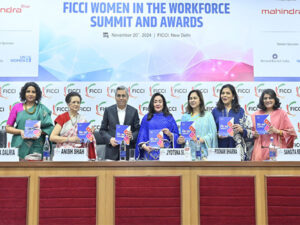
Mumbai (Maharashtra) [India], June 7 (ANI): In a bid to bolster the safety and security of digital payments and enhance regulatory frameworks, the Reserve Bank of India (RBI) unveiled a series of proposals aimed at fostering innovation, inclusivity, and efficiency in the financial ecosystem.
These initiatives, announced by RBI Governor Shaktikanta Das, signify the central bank’s commitment to fortifying India’s digital infrastructure and promoting a conducive environment for financial transactions.
One of the key announcements made by Governor Das pertained to the establishment of a Digital Payments Intelligence Platform.
This platform, leveraging advanced technologies, aims to mitigate payment fraud risks and enhance the safety of digital transactions.
According to the annual report released by the Reserve Bank of India (RBI) on May 30, there was a significant surge in the number of financial frauds reported by banks, increasing by 166 per cent year-on-year in the financial year 2023-24 to reach 36,075 cases.
This figure starkly contrasts with the 13,564 cases reported in the previous fiscal year, FY23.
Despite the notable rise in the number of fraud cases, there was a substantial decrease in the total amount involved in these incidents.
The amount of money associated with total bank frauds plummeted by 46.7 per cent year-on-year in the financial year 2023-24, totaling Rs 13,930 crore.
In comparison, the amount recorded in FY23 stood at Rs 26,127 crore.
RBI has proposed a revision of the limit of bulk deposits for Scheduled Commercial Banks (SCBs) and Small Finance Banks (SFBs). This move, aimed at enhancing flexibility and aligning with evolving market dynamics, underscores the RBI‘s commitment to fostering a conducive environment for the banking sector.
Currently, banks have the discretion to offer differential rates of interest on bulk deposits based on their requirements and Asset-Liability Management (ALM) projections. The existing bulk deposit limit for SCBs (excluding Regional Rural Banks) and SFBs, set at ‘Single Rupee term deposits of Rs 2 crore and above,’ was established in 2019.
However, following a comprehensive review, the RBI has proposed to revise this definition to ‘Single Rupee term deposits of Rs 3 crore and above’ for SCBs and SFBs.
In addition to the proposed revision for SCBs and SFBs, the RBI has also suggested defining the bulk deposit limit for Local Area Banks (LABs) as ‘Single Rupee term deposits of Rs 1 crore and above,’ mirroring the criteria applicable to Regional Rural Banks (RRBs).
RBI has also unveiled plans to rationalize export and import regulations under the Foreign Exchange Management Act (FEMA), 1999. This initiative, driven by the imperative of progressive liberalization and operational flexibility, underscores the RBI‘s commitment to fostering a conducive environment for international trade and investment.
By eliminating redundancies, enhancing clarity, and reducing procedural complexities, the RBI aims to promote ease of doing business for all stakeholders involved in cross-border trade.
The RBI aims to streamline and simplify operational procedures related to export and import transactions, thereby reducing administrative burdens and enhancing efficiency for businesses and authorized dealer banks.
By aligning regulations with international best practices and market realities, the RBI seeks to create a business-friendly environment conducive to fostering trade and investment growth. Simplified regulations will facilitate smoother trade transactions, encouraging businesses to explore new markets and expand their global footprint.
While promoting ease of doing business, the RBI remains committed to ensuring compliance with regulatory requirements and safeguarding the integrity of the financial system. The proposed rationalization will uphold the principles of transparency, accountability, and risk management in cross-border transactions.
As part of the process, the RBI plans to publish draft regulations and directions on its official website by the end of June 2024.
In a bid to enhance the convenience and efficiency of digital payments, RBI has unveiled plans to expand the e-mandate framework to include recurring payments for Fastag, National Common Mobility Card (NCMC), and similar services.
This initiative, aimed at modernizing payment systems and promoting financial inclusion, underscores the RBI‘s commitment to fostering innovation and leveraging technology to meet evolving consumer needs.
The current UPI Lite service permits customers to load their UPI Lite wallets with up to Rs 2000/- and conduct transactions of up to Rs 500 from the wallet.
To enhance the seamless usage of UPI Lite for customers, and in response to feedback from various stakeholders, it is suggested to integrate UPI Lite into the e-mandate framework.
This integration would introduce an auto-replenishment feature for UPI Lite wallets, automatically refilling the wallet balance when it falls below a predetermined threshold set by the customer.
Since the funds remain under the customer’s control (transferring from their account to the wallet), it is proposed to eliminate the need for additional authentication or pre-debit notifications. Relevant guidelines pertaining to this proposal will be issued shortly.
RBI has embarked on a mission to foster innovation and transformation in the financial sector with the launch of its third edition of the global hackathon, “HARBINGER 2024 – Innovation for Transformation.”
It would feature two primary themes: ‘Zero Financial Frauds’ and ‘Being Divyang Friendly.’ Solutions aimed at bolstering the safety and security of digital transactions, with a specific emphasis on identifying, preventing, and combating financial frauds, will be solicited.
Additionally, there will be a focus on fostering inclusivity for individuals with physical disabilities. Further details regarding the hackathon will be unveiled shortly. (ANI)
RBI revises GDP growth for FY25 to 7.2 pc, inflation target remains at 4.5pc
Mumbai (Maharashtra) [India], June 7 (ANI): The RBI has revised the GDP forecast for the current FY 24-25 to 7.2 per cent from 7 per cent earlier, and the CPI inflation is projected at 4.5 per cent.
Announcing the policy rates and GDP forecasts on Friday, RBI Governor Shaktikanta Das said, “The real GDP growth for the current financial year 2024-25 is projected at 7.2 per cent with Q1 at 7.3 per cent, Q2 at 7.2 per cent, Q3 at 7.3 per cent, and Q4 at 7.2 per cent. The risks are evenly balanced.”
On the Inflation the RBI Governor added that “Assuming a normal monsoon, CPI inflation for 2024-25 is projected at 4.5 per cent with Q1 at 4.9 per cent, Q2 at 3.8 per cent, Q3 at 4.6 per cent and Q4 at 4.5 per cent, the risks are evenly balanced. The GDP growth projection, we have increased it from 7 per cent to 7.2 per cent and the inflation projection, the average for the year, we have retained it at 4.5 per cent as it was in the last MPC meeting.
Das reiterated the MPC’s commitment to withdrawing accommodation gradually to ensure that inflation aligns with the targeted range while supporting economic growth.
“Monetary policy must continue to remain disinflationary and be resolute in its commitment to aligning inflation to the target of 4 per cent on a durable basis sustain price stability outset strong foundation,” the RBI Governor said.
The decision to keep the Repo Rate unchanged signals the RBI‘s cautious approach towards balancing the objectives of controlling inflation and supporting economic recovery.
The food inflation is still above the normal limit and continuously posing challenge to the deflation process of RBI.
The RBI in its Monetary Policy Committee (MPC) has decided to keep the policy repo rate unchanged at 6.5 per cent as retail inflation continues to be above its target of 4 per cent.
The MPC, in a majority decision with four out of six members in agreement, opted to keep the Repo Rate unchanged.
Consequently, the standing deposit facility (SDF) rate remains at 6.25 per cent, while the marginal standing facility (MSF) rate and the bank rate remain at 6.75 per cent.
Governor Das, in his post-policy press conference, emphasised the importance of a balanced approach towards monetary policy. (ANI)
RBI enhances contingent reserve buffer to 6.5 pc amid positive economic outlook
Mumbai (Maharashtra) [India], June 7 (ANI): The Reserve Bank of India (RBI) on Friday announced the enhancement of the Contingent Reserve Buffer from 6 per cent to 6.5 per cent.
Das today announced the results of the Monentary Policy Committee meeing, which began its three-day meeting on Wednesday, in the immediate backdrop of Lok Sabha election results.
Governor Shaktikanta Das today revealed that the Consumer Price Index (CPI) inflation for the financial year 2024-25 is projected at 4.5 per cent.
This projection aligns with the RBI‘s commitment to maintaining price stability while fostering sustainable economic growth.
Governor Das address referenced the provisional estimates released by the National Statistical Office (NSO), which placed India’s real gross domestic product (GDP) growth at an impressive 8.2 per cent for the fiscal year 2023-24.
He emphasized that during the ongoing fiscal year 2024-25, domestic economic activity has exhibited resilience, with manufacturing activity witnessing robust growth propelled by strengthening domestic demand.
Governor Das said that India accounts for 15.2 per cent of the world’s remittances, highlighting the significant contribution of overseas Indian workers to the country’s economy.
This substantial influx of remittances underscores India’s strong ties with its diaspora and its ability to leverage human capital for economic development.
Moreover, Foreign Direct Investment (FDI) inflows into India reached an impressive USD 41.6 billion, reflecting investor confidence in the country’s business environment and growth prospects.
The gross Non-Performing Assets (NPAs) of all scheduled commercial banks and Non-Banking Financial Companies (NBFCs) remained below 3 per cent.
India’s foreign exchange reserves have soared to a historic high of USD 651.5 billion as of May 31, underlining the country’s strong position in terms of liquidity and external stability.
Das emphasised, “India’s Foreign exchange reserve reached a historical high of USD 651.5 billion as on May 31.”
Furthermore, India’s external sector remains resilient, with key vulnerability indicators showing continuous improvement.
This resilience is a testament to the country’s ability to navigate global economic challenges and underscores its position as a key player in the international arena.
Highlighting key indicators of economic performance, Governor Das noted the healthy growth recorded by the eight core industries in April 2024.
Additionally, he underscored the strength exhibited by the Purchasing Managers Index (PMI) in the manufacturing sector, which soared to its highest level globally in May 2024.
Furthermore, the services sector maintained its buoyancy, evident from the robust expansion indicated by a PMI services reading of 60.2 in May 2024.
Governor Das reiterated the RBI‘s commitment to maintaining a balanced growth-inflation trajectory, stating, “
The inflation growth balance is moving favourably. Growth is holding firm. Inflation continues to moderate, mainly driven by the core component, which reached its lowest level in the current series In April 2024. The deflation in fuel prices is ongoing. Food inflation, however, remains elevated. While the MPC took note of the disinflation achieved so far without hurting growth, it remains vigilant to any upside risks to inflation, particularly from food inflation, which could possibly derail the path of disinflation.
He added, “Hence, monetary policy must continue to remain disinflationary and be resolute in its commitment to aligning inflation to the target of 4 per cent on a durable basis. Sustained price stability would set strong foundations for a period of high growth.”
He acknowledged the ongoing deflation in fuel prices but highlighted that food inflation remains elevated.
While acknowledging the achievements in disinflation without compromising growth, Governor Das stressed the importance of vigilance against potential upside risks to inflation, particularly stemming from food prices.
He emphasized that monetary policy must remain disinflationary and resolute in aligning inflation with the target of 4 per cent on a durable basis.
Sustained price stability, according to Governor Das, lays the groundwork for a period of robust economic growth. (ANI)


















